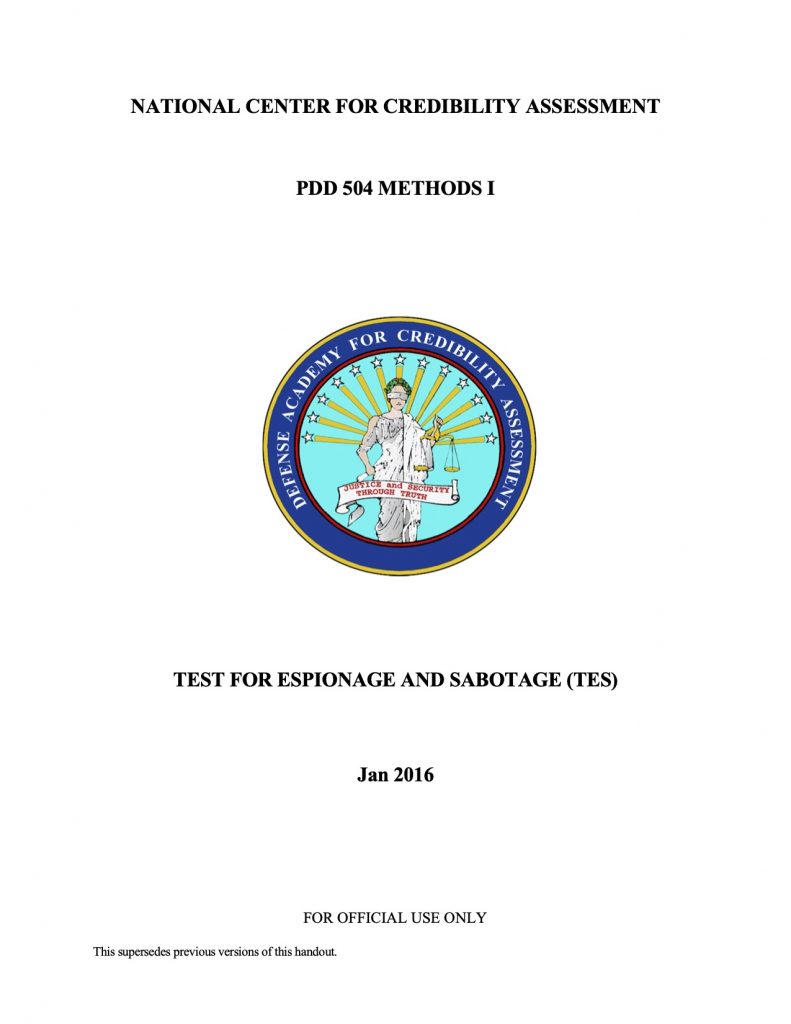
The “Test for Espionage and Sabotage” is the primary counterintelligence-scope polygraph screening format employed by the U.S. Departments of Defense and Energy. The procedure is described in detail in a 2016 National Center for Credibility Assessment administration guide (1.2 MB PDF) obtained by AntiPolygraph.org.
The guide, marked “For Official Use Only,” sets forth the relevant, “control”/comparison, and irrelevant questions asked. Appendix A (“Scoping Guide for Relevant Questions”) provides detailed information about the topics covered by the relevant questions.
Topics that are off-limits (“unless these issues are revealed by the examinee as having relevance to responses or admissions made in connection with counterintelligence questions posed during the examination”) include:
- Religious beliefs or affiliations
- Beliefs and opinions regarding racial matters
- Political beliefs and affiliations
- Opinions regarding the constitutionality of legislative policy
- Use of drugs or alcohol (except for purposes of assessing suitability)
- Affiliation with labor unions
- Sexual matters
- Finance
In other words, if the examinee doesn’t bring up these topics, the polygraph operator is not supposed to do so. AntiPolygraph.org has nonetheless heard reports of some polygraph operators ignoring these restrictions, and we invite any readers with knowledge of such practices to privately contact us.
Appendix F (“TES Outline”) will be of special interest, as it provides the basic script for conduct of the Test for Espionage and Sabotage. It is essentially a synopsis of the entire monkey drill.
It should be noted that in a secret experiment conducted at the National Center for Credibility Assessment (then called the Department of Defense Polygraph Institute), 80 percent of subjects succeeded in beating the Test for Espionage and Sabotage after an hour-long training session.
There is no documented instance of the Test for Espionage and Sabotage ever catching a spy or saboteur.
The polygraph community is quite concerned about polygraphy’s vulnerability to simple, effective countermeasures that they cannot detect, and the TES therefore includes a “Countermeasures statement,” which the guide explains thus:
10.2. Countermeasures statement: It is important to provide some form of countermeasures statement to make the examinee aware that non-cooperation or deliberate efforts to influence testing will adversely affect the examination process. There are a number of approaches to this issue. The following is one such approach:
10.2.1. “It is not uncommon for people who have to take a polygraph examination to research information on the topic. Often, they come across sites or read articles that suggest they have to perform some activity to help them through their polygraph examination. Such sites and articles often provide bogus information. In fact, when people attempt to influence the outcome of their polygraph examination in various ways, such activity reveals that they have abdicated their responsibility to tell the truth and are being non-cooperative. Can I count on you not to involve yourself in such activity?”
It is ironic (and hypocritical) for polygraph operators, whose techniques require that they lie to and attempt to deceive those whom they “test,” to speak of any “responsibility to tell the truth.” For discussion of the trickery behind the Test for Espionage and Sabotage, see AntiPolygraph.org co-founder George Maschke’s article, “The Lying Game: National Security and the Test for Espionage and Sabotage.”
Those who wish to learn more about polygraphy’s scientific shortcomings—and what can be done to mitigate the risk of a false positive outcome—will want to download a copy of AntiPolygraph.org’s free book, The Lie Behind the Lie Detector.